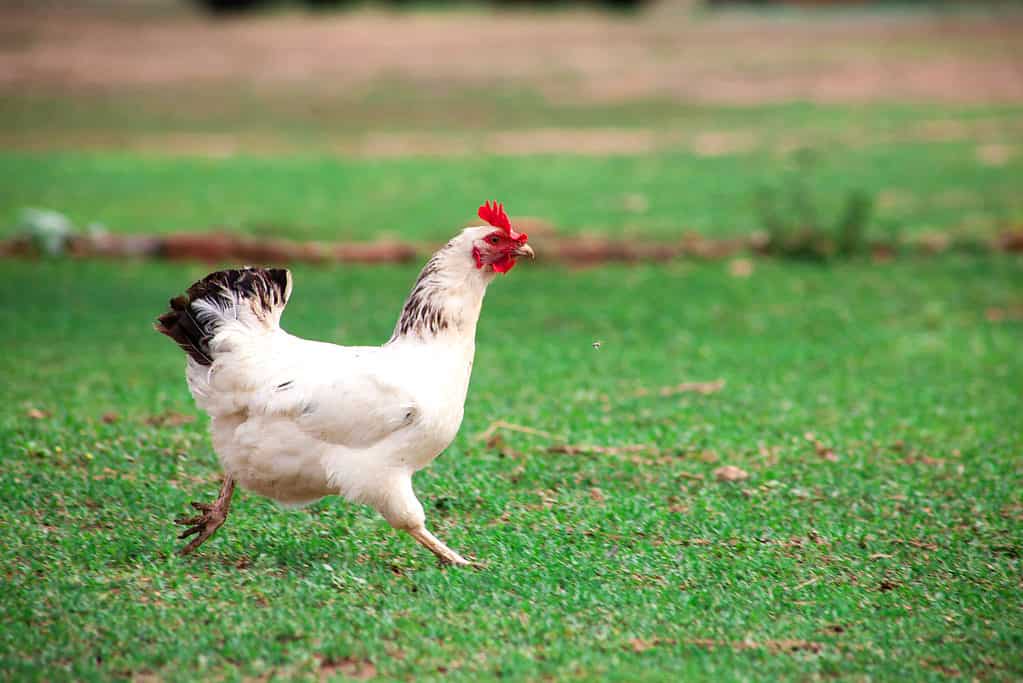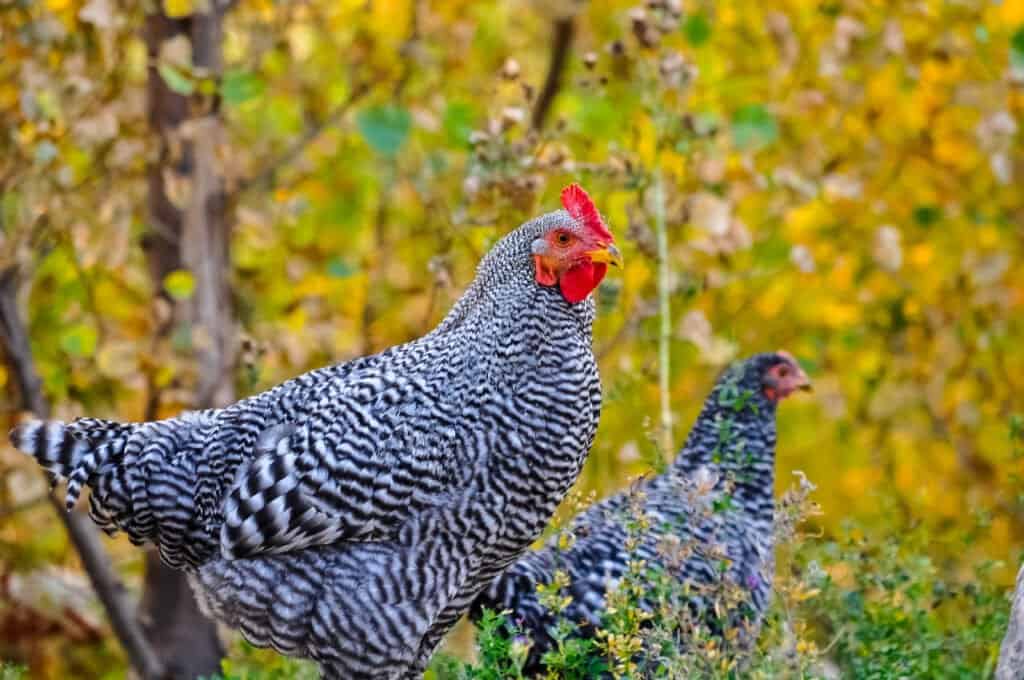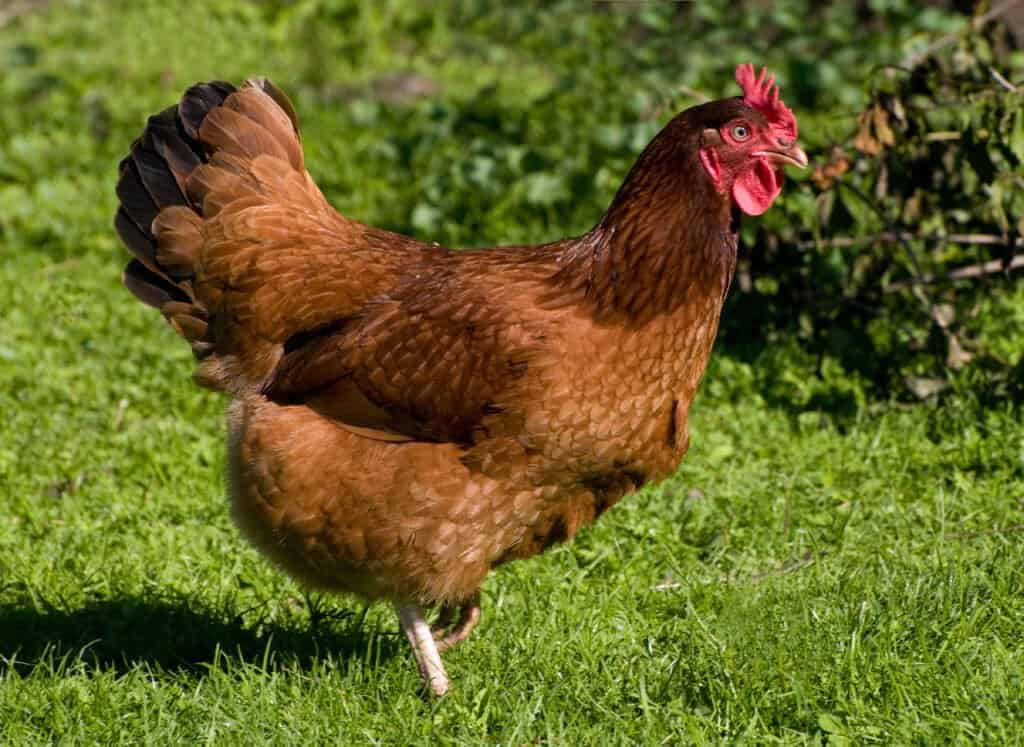Fresh eggs from your own happy hens are hard to beat, and hens make lovely, friendly pets, too. If you have space to care for a few chickens, they are more than worth the effort for golden-yolked, tasty breakfasts. But what type should you buy? Here are some of the best chickens for laying delicious eggs.
1. Dorking Chicken

A Dorking hen weighs around 8-10 lbs; they have rectangular bodies and short legs but are excellent fliers that like to roost in trees.
©iStock.com/Mironmax Studio
Dorking chickens are gentle birds laying approximately 160-180 delicious eggs yearly.
These friendly chickens are English natives and quite rare. There are five recognized color varieties: white, silver-gray, dark, red, and cuckoo. Their plumage color affects their egg color, so you can never be sure what egg color you’ll get!
A Dorking hen weighs around 8-10 lbs; they have rectangular bodies and short legs but are excellent fliers that like to roost in trees. Their erect red combs make them susceptible to cold weather, so Dorkings are not the best choice for very cold zones.
They mature slowly and start to lay around the age of two years. This slow process contributes to a healthy bird and the regular production of delicious eggs.
2. Leghorn

Leghorns are white with bright red combs and lay 55-gram clean, white-shelled eggs when they reach around 18 weeks.
©Jay-Dee/Shutterstock.com
The famous Leghorn is one of the United States’ favorite chickens because they produce many eggs, up to 300 a year. They are named after a small town in Italy, where they originated, but you’ll find two Leghorn breeds in America. One is bred for the egg market, and the other is a heritage bird that’s less productive but generally healthier in a backyard.
Leghorns are white with bright red combs and lay 55-gram clean, white-shelled eggs when they reach around 18 weeks. They are one of the best chickens for laying delicious eggs, but they aren’t for beginners because they have feisty temperaments.
3. Plymouth Rock

Plymouth rocks are large birds that weigh seven to eight lbs.
©Jennifer de Graaf/Shutterstock.com
Historically, Plymouth Rock hens were the most popular chicken in the United States because they are gentle, good-eating birds that produce up to 200 delicious eggs a year. Commercial producers have bred chickens to produce larger eggs, so over time, the Plymouth Rock fell out of favor. However, they make excellent pet chickens with the bonus of large light brown eggs from 18-22 weeks.
Plymouth rocks are large birds that weigh seven to eight lbs. There are seven recognized colors in the U.S. They are silver-penciled, white, barred, buff, blue, Columbian, and partridge, but no matter what their plumage color, they are sweet-tempered birds with flavorsome eggs.
4. Rhode Island Red

Rhode Island Red Chickens are friendly, inquisitive, and gentle.
©Ariene Studio/Shutterstock.com
They are popular birds for their friendly, inquisitive nature and gentle pet-like temperament. They’re also one of the best chickens for laying delicious eggs because they produce large brown eggs with golden yellow yolks from 18-20 weeks old. As Rhodey ages, her eggs get slightly larger! These intelligent hens lay 250-300 eggs yearly, making them one of the most prolific layers. Because they are easy to care for and gentle, Rhodeys are a great choice for novice chicken keepers.
Rhode Island Reds have stiff red and black foliage and bright red combs. As well as producing delicious eggs, these clever chickens are predator-savvy. They always have one eye on their surroundings!
There are two varieties of Rhode Island Red. One is the commercial bird used for intensive egg production, and the other is a heritage variety that’s usually best for backyard egg laying and meat. The heritage variety is a little slower growing and less productive in the egg department but healthier overall.
5. Orpington

Orpington hens can lay over 200 light-brown yellow-yolked eggs a year.
©galitsin/Shutterstock.com
Buff-colored Orpington chickens are loved for their pretty colored foliage, so they are popular backyard birds, but do they produce delicious eggs?
Yes! Orpingtons hens are an old breed from Britain that’s friendly, docile, quickly matures, and lays over 200 light-brown yellow-yolked eggs a year.
They are large and fluffy eight-pound birds that get on well with other breeds, so you can mix them with other varieties for a range of different delicious eggs. Although buff is the standard color, Orpingtons are also white and blue-gray.
If you’re looking for hens that lay lots of eggs but also make excellent pets, Orpingtons are a great choice. They will happily sit on your lap for pets!
6. Sussex

Sussex hens are medium-sized birds.
©Erwin Bosman/Shutterstock.com
These chickens originated in Sussex, England, where they were originally dual-purpose birds for eggs and meat. From the age of 16-20 weeks, these hens produce around 180-250 large, light-brown eggs every year.
These hens are medium-sized birds. They weigh around seven pounds, with long flat backs, rectangular shapes, and a 45-degree perky tail. Light-plumaged Sussex chickens have orange eyes, and dark-feathered varieties have red eyes.
These beauties are placid, docile hens that like to follow owners around the garden and hop on their laps. Sussex roosters are placid, too, so if you’re looking for a never-ending supply of delicious eggs (and don’t mind waking up early), Sussex roosters are ideal.
7. Ex Commercial Hens

There are 380 million commercial hens in the U.S., and 2/3 are caged.
©Guitar photographer/Shutterstock.com
The majority of us eat commercial hen eggs from a store. There are 380 million commercial hens in the U.S., and 2/3 are caged. When they reach the end of their most productive stage (around a year to 18 months), they are sold off, often ending up in pet food. At this point, they can still produce 300 eggs a year.
It’s possible to rescue these hens. Many charities work with commercial egg farms to rehome their egg layers. The breeds vary but are proven, productive hens that still have years of life left.
Commercial hen eggs are tasty and rehoming them is ultimately satisfying as you watch them rise from tatty and depressed girls into shiny, healthy, happy chickens. They are docile and friendly, and even if they have issues from living in a small cage, they quickly grow used to space, freedom, and love.
Best Diet for Delicious Eggs
So you’ve picked the best chickens for laying delicious eggs, now what do you feed them?
Like all animals, good quality food leads to better health, and healthy chickens are more productive. Hens need good quality complete chicken pellets, grain mix, or mash with the right balance of nutrients to lay lots of eggs.
Good layers also need extra calcium to form shells, so a bowl of grit, such as crushed oyster shells, is essential. In the wild, birds obtain calcium from insects and mollusks, but captive birds don’t roam and forage so much.
All yard chickens should be regularly de-wormed, and they must always have fresh water to drink.
And treats? Treats are the best bit for chicken keepers! Chickens universally love treats from tinned fish to sweetcorn, greenery, and even watermelon. However, it’s best to keep the treats minimal because they really need to eat their layer’s pellet food first. This will ensure a good supply of nutrients that lead to delicious, strong-shelled eggs.
Hens are like toddlers. They eat their favorites first. Watermelon over pellets any day of the week!

All yard chickens should be regularly de-wormed, and they must always have fresh water to drink.
©Lou Sisneros Photography/Shutterstock.com
Best Egg-Laying Breeds
Many chicken breeds lay delicious eggs, but some of the best layers are:
- Dorking
- Rhode Island Red
- Leghorn
- Plymouth Rock
- Orpington
- Sussex
- Ex Commercial Hens
Given dry shelter, protection from predators, a healthy layer’s pellet diet, supplementary grit, fresh water, and occasional treats, all these hens will lay eggs for years.
The most cost-effective way to start an egg-producing flock is with ex-commercial hens that sell for less than their oven-ready store price all year round. Pure breeds are more expensive and generally only available at certain times of the year.
Either way, getting delicious eggs from your chickens is satisfying, and you’ll make many new feathery friends along the process.
Bonus: Tips for Keeping Your Chickens Safe From Predators
Whether you have a self-contained coop or one that allows your chickens access to a portion of your yard — you may need to take extra measures to keep your chickens safe. Here are some expert-recommended methods of keeping your chicken coop safe from predators.
- Be aware of the likely predators in your area. Many animals, such as coyotes, foxes, and raccoons, can be deterred by strategically placed motion lighting.
- Bury chicken wire at least 4 feet deep if your coop doesn’t have a floor.
- Top your chicken run with chicken wire to stop birds of prey from attacking your flock.
- Keep the grass cut low around your chicken coop and run to provide visibility and to give predators no place to hide.
- Weasels and snakes can squeeze through a half-inch hole – block any access hole.
- Lock your chickens up at night using a mechanism that intelligent creatures like raccoons can’t figure out.
- Keep your chicken pen clean to prevent rodents.
- Collect your eggs daily to deter rats and snakes.
- Install motion sensor lighting around the chicken coop. Consider modifying them to send out an alarm to notify you if they are activated.

You may need to take extra measures to keep your chickens safe — even if they have a cozy coop!
©Cynthia Farmer/Shutterstock.com
Summary of the Best Chickens for Laying Delicious Eggs
Refer to this handy guide when selecting chickens for your backyard flock.
| Chicken Breed | Eggs per Year | Temperament | |
|---|---|---|---|
| 1 | Dorking Chicken | 160 – 180 | Friendly |
| 2 | Leghorn | 300 | Fiesty |
| 3 | Plymouth Rock | 200 | Sweet |
| 4 | Rhode Island Red | 250 – 300 | Friendly, gentle |
| 5 | Orpington | 200 | Friendly, docile |
| 6 | Sussex | 180 – 260 | Docile |
| 7 | Ex Commercial Hens | 300 | Friendly, docile |
The photo featured at the top of this post is © ANEK SANGKAMANEE/Shutterstock.com
Thank you for reading! Have some feedback for us? Contact the AZ Animals editorial team.






